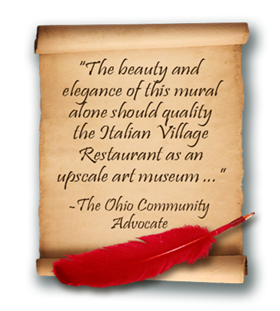



Cleveland, Ohio, USA, 2002. I have been labouring atop of my scaffold at the Gordon Square Theatre (see the Gordon Square Ceiling Mural) painting the ceiling mural when I accepted a commission to paint a panoramic mural at a restaurant. It is not uncommon for me to work on several commissions simultaneously but I jumped at the chance of doing another mural because I desperately needed a change of pace after a year of slow and painful progress at the Gordon.

|
The Gordon Square Theater Ceiling Mural in progress (2001-2004). I was in the middle of this project when I got the call to do the Italian Village Restaurant mural. I needed a change of pace and this was a welcome break from suffering on a ceiling. |
The Italian Village is an excellent family-style Italian food restaurant located in Strongsville, a small town south of the Greater Cleveland area. It is owned and operated by Mr. Michael "Mike" Santo (Santosuosso) and his wife Debbie -and they are simply marvellous people. The food is as good as some of my favourite spots in Italy.
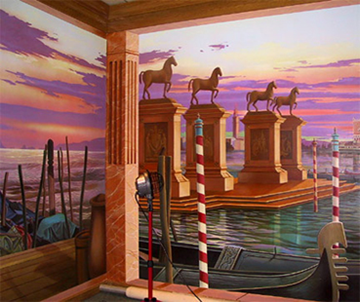 |
||
|
The Italian Village Restaurant "Comune di Venezia" mural was a fun mural to paint -a rare exception. This image shows a section of the mural I had just finished working on. Notice a roll of protective tarp on the floor as well as one of my lamps (I painted mostly during the night). |
The theme of the mural was to be the city of Venice, Italy, which I had the pleasure of visiting in the fall of 2000. My recollection of its sites and people was still very vivid and I set out to recreate as many of the city's landmarks as I could. The city of Venice is one of the world's most popular tourist attractions visited by hundreds of thousands every year. This meant that I had to be very accurate in my visual recreation because chances were that a lot of the viewers had visited the historical site and were familiar with its landscape.
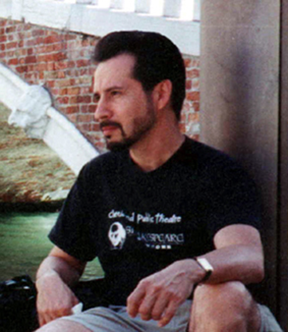
|
The city of Venice is a treasure trove for history buffs like me. I studied and mentally catalogued its marvellous architecture and artistic treasures. I trully fell in love with the city. |
Feeling like my old self again, I completed this baby in 36 days flat! It only goes to show that painting ceilings is a drag when compared to walls at eye level. It was also comforting to do the painting in acrylics, which are water based paints, instead of oils. Oils are my preferred medium but when it comes to speed nothing beats acrylics. The demands and techniques are different and I enjoy the pacing.
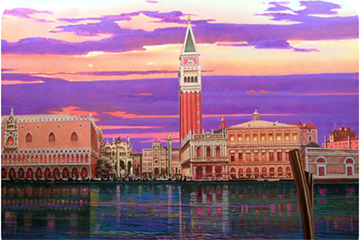
|
Mural detail of the city of Venice. Lush sunset colors add to the magic of scene. |
Doing a commission on a theme where I was left free to generate my own imaginings made for good art -and a happy John. But another one of the joys of painting this mural was that I was working "live", performing for an enthusiastic audience of restaurant patrons, and even more so after a live TV show was taped while the work was in progress. Mike actually requested that I work during restaurant hours as an added attraction for his customers. There were people coming on a daily basis to see me paint, asking questions or sharing their traveling experiences in Italy. Most artists I know can't do this; they avoid distractions to concentrate on the painting. But I plan my compositions in advance and the act of painting is more or less boring execution. I welcome such distractions.
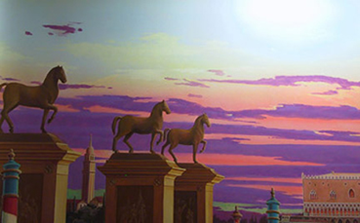
|
The famous bronze horses of Venice arranged in my capricious setting. The four horses have a rich history and now rest inside the Basilica of Saint Mark in Piazza San Marco. |
To be able to paint this kind of mural on a tight schedule you have to prepare well and be very methodical. The first thing I did was to divide the painting of the mural in daily tasks and then stick to the timetable. Therefore I knew in advance that I needed a minimum of 30 days to finish the job (or 6 weeks if you do not work on week-ends). I simply work by doing a daily count-down so that I can get excited about reaching the end.

|
Detail of a gondolier. Several styles of painting were combined to achieve optical movement. |
I created this mural using acrylic paints but I used glazing techniques normally associated with oil painting. The difference is that instead of oil, water is used. You just have to paint faster. I rendered certain elements in an impressionistic fashion; other areas were more photorealistic. Painting water, for example, is ideal for an impressionistic technique because this also adds an optical illusion of movement. Notice in the image above how well these techniques work producing spectacular results. I have never been a purist; I will try anything that works in creating the final illusion in the least amount of time.
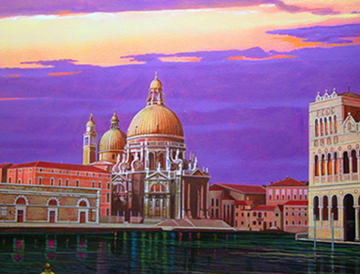
|
I included many landmarks of Venetian architecture, such as: the Basilica di Santa Maria della Salute (Basilica of St Mary of Health/Salvation), situated at the entrance of the Grand Canal. |
Many people have asked me over the years how I paint murals -and, "can you teach me how to paint". The first question is not easy to answer because I never really think about it. I plan well in advance and go over most details before the first brushstroke hits the wall. Once I have a clear vision of what the final rendering will be, I have the luxury of not having to "work" the painting during the execution. Instead I channel my attention somewhere else. I listen to audio tapes most of the time or day dream. Sometimes I take a few pictures of works in progress to show during lectures and presentations.
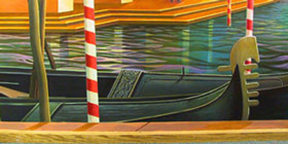
|
Painting an architectural framework helped create a transition between reality and illusion. You can almost step into the gondola (painted life-size) and go for a ride. |
However, for the first, for all of you who want to learn how to paint, I have prepared a step-by-step presentation of how this mural was done. I explain everything in detail -with images, including specific descriptions of materials, methods, techniques, tips and tricks, as well as the planning and thought process that goes into creating this type of artwork. The presentation is at the bottom of this page. You can read it on this page or download the PDF file to your computer. Just keep in mind that this is a large file so the download may take several minutes.
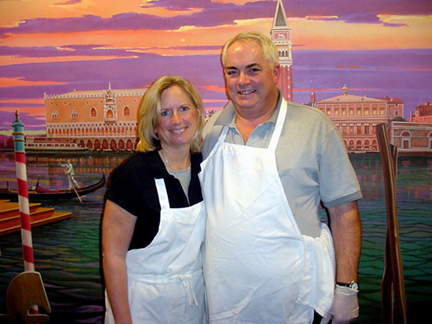
|
A nice touch of inspiration: Mike and Debbie Santo, the propriators of the Italian Village Restaurant, ended up in the mural. |
I consider this mural one of my better ones. This commission had everything going for it: good walls, great atmosphere, an interesting subject matter, a fantastic audience and perfect clients. In fact, I was so taken by Mike and Debbie that I included them in the scene. So if you happen to be in the Cleveland area, stop by to see the mural and enjoy a fantastic meal. Here's the link to the restaurant's website:
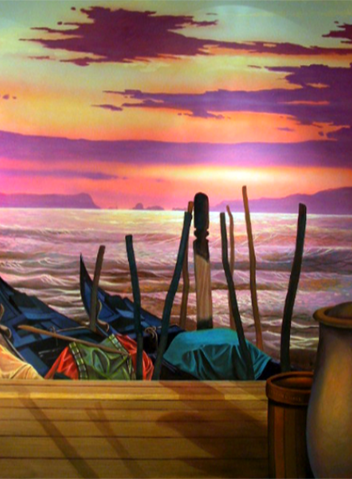
|
||
|
My favorite section of the mural. I know that a few days before this was just paint in a can and now that paint in on the wall. But it never fails to amaze me what you can achieve with it. Perhaps this is why so many artist truly feel like they have a touch of the divine. It sounds presumptious coming from an atheist but... just look at it! A painting can be a gorgeous creation -even if it is only an illusion. |
Now, before I finish this narrative, I want to tell you about one of my greatest pet-peeves about artists. And it is: artists whose signatures are so distracting that they never fail to annoy me. Ridiculously large and stylized signatures stand out like neon signs. An artist's signature has to accomplish two things: identify the artist, and date the work. With large murals sometimes additional data is included if, for example, the job is a group effort or it there is some special significance that has to be pointed out. I customarily included a phone number where I could be reached. Nowadays I simply include my website's address. Anyone interested in contacting me can go to the website, see examples of my work, read my bio and resume, and get my e-mail address from the contact page. This works extremely well.
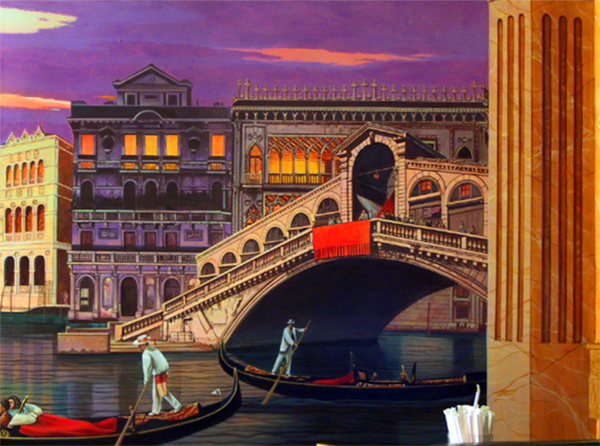
|
A signature and credits work best when incorporated into the composition so it does not distract from the enjoyment of the illusion. |
However, the best signatures are those that do not distract the viewer from the pleasure of appreciating the artwork. If you can incorporate your signature into the mural as if it belongs there, then do so. In the above example I have signed the work on an advertising tapestry that the art museum in Venice uses to advertise current art exhibitions. It is hung over the Rialto Bridge where it is seen by just about everyone traveling in water taxis or walking on any of the converging streets. People expect to see lettering on that spot. If I am doing a cityscape with modern architecture, there is a good probability that my signature will be on a billboard!
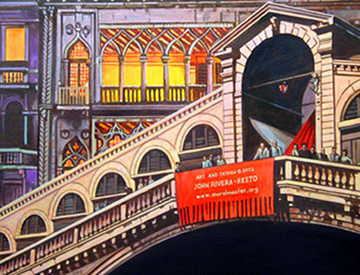
|
My calling card hanging over the Realto bridge. |
As you can see, with a little creativity you can make the positioning of your signature your trademark. Also, make sure that the lettering fits the style of the artwork. And, don't forget to balance the coloring of the signature with the rest of the artwork. If the color appears too bright -or too dark, it will be distracting. Oh, one last thing, make it legible. Don't you want to be recognized?
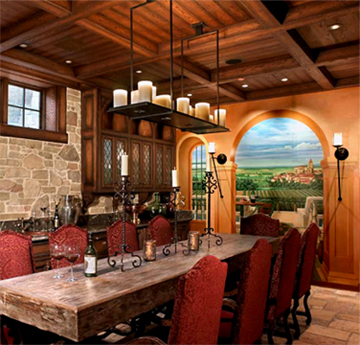
|
For another mural with a similar style and subject, see also The Wolstein Château Wine Room Murals. |